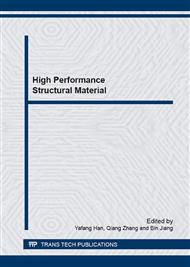[1]
P. Simon, J.P. Fishbach, P. Riche, Ultra-fast cooling on the run-out table of the hot strip mill, Revue de Metallurgie. 93(1996) 409-415.
Google Scholar
[2]
A. Lucas, P. Simon, G. Bourdon, J.C. Herman, P. Riche, J. Neutjens, P. Harlet, Metallurgical aspects of ultra-fast cooling in front of the down-coiler, Steel Research. 75(2004) 139-146.
DOI: 10.1002/srin.200405939
Google Scholar
[3]
H. Kagechika, Production and technology of iron and steel in Japan during 2005. ISIJ International. 46(2006) 939-958.
DOI: 10.2355/isijinternational.46.939
Google Scholar
[4]
G.D. Wang, The new generation TMCP with the key technology of the ultra-fast cooling, Shanghai Metals. 30(2008) 1-4.
Google Scholar
[5]
G.D. Wang, New generation TMCP and innovative hot Rolling process, Journal of Northeastern University: Natural Science. 30(2009) 913-922.
Google Scholar
[6]
L.A. Brignoni, S.V. Garimella, Effects of nozzle-inlet chamfering on pressure drop and heat transfer in confined air jet impingement, International Journal of Heat and Mass Transfer. 43(2000) 1133-1139.
DOI: 10.1016/s0017-9310(99)00207-0
Google Scholar
[7]
A. Sarkar, N. Nitin, M. Karwe, R.P. Singh, Fluid flow and heat transfer in air jet impingement in food processing, Journal of Food Science. 69(2004) 113-122.
DOI: 10.1111/j.1365-2621.2004.tb06315.x
Google Scholar
[8]
M.F. Koseoglu, S. Baskaya, The role of the inlet geometry in impinging jet heat transfer, model and experiments, International Journal of Themal Sciences. 49(2010) 1417-1426.
DOI: 10.1016/j.ijthermalsci.2010.02.009
Google Scholar
[9]
M. Zukowski, Heat transfer performance of a confined single slot jet of air impinging on a flat surface, International Journal of Heat and Mass Transfer. 57(2013) 484-490.
DOI: 10.1016/j.ijheatmasstransfer.2012.10.069
Google Scholar
[10]
F. Afroz, M.A. R Sharif, Numerical study of heat transfer from an isothermally heated flat surface due to turbulent twin oblique confined slot-jet impingement, International Journal of Thermal Sciences. 74(2013) 1-13.
DOI: 10.1016/j.ijthermalsci.2013.07.004
Google Scholar
[11]
A.W. Momber, Concrete failure due to air-water jet impingement, Journal of Materials Science, 35(2000) 2785-2789.
Google Scholar
[12]
N. Sozbir, Y.W. Chang, S.C. Yao, Heat transfer of impacting water mist on high temperature metal surfaces, Journal of Heat Transfer, 125(2003) 70-74.
DOI: 10.1115/1.1527913
Google Scholar
[13]
P. Bhattacharya, A.N. Samanta, S. Chakraborty, Spray evaporative cooling to achieve ultra fast cooling in runout table, International Journal of Thermal Sciences. 48(2009) 1741-1747.
DOI: 10.1016/j.ijthermalsci.2009.01.015
Google Scholar
[14]
S.V. Ravikumar, J.M. Jha, S.S. Mohapatra, A. Sinha, S.K. Pal, S. Chakraborty, Experimental study of the effect of spray inclination on ultrafast cooling of a hot steel plate, Heat Mass Transfer. 49(2013) 1509-1522.
DOI: 10.1007/s00231-013-1190-3
Google Scholar
[15]
S.S. Mohapatra, S.V. Ravikumar, S.K. Pal, S. Chakraborty, Ultra-fast cooling of a hot steel plate by using high mass flux air atomized spray. Steel Research International. 84(2013) 229-236.
DOI: 10.1002/srin.201200157
Google Scholar
[16]
M.A. Wells, D. Li, S.L. Cockcroft, Influence of surface morphology, water flow, and sample thermal history on the boiling-water heat transfer during direct-chill casting of commercial aluminum alloys, Metallurgical and Materials Transactions B. 32(2001).
DOI: 10.1007/s11663-001-0079-6
Google Scholar
[17]
D. Li, M.A. Wells, S.L. Cockcroft, E. Caron, Effect of sample start temperature during transient boiling water heat transfer, Metallurgical and Materials Transactions B. 38(2007) 901-910.
DOI: 10.1007/s11663-007-9091-9
Google Scholar
[18]
A. Guha, R.M. Barron, R. Balachandar, An experimental and numerical study of water jet cleaning process, Journal of Materials Processing Technology. 211(2011) 610-618.
DOI: 10.1016/j.jmatprotec.2010.11.017
Google Scholar
[19]
S.S. Mohapatra, S.V. Ravikumar, A. Verma, S.K. Pal, S. Chakraborty, Experimental investigation of effect of a surfactant to increase cooling of hot steel plates by a water jet, Journal of Heat transfer. 135(2013) 0321011-0321017.
DOI: 10.1115/1.4007878
Google Scholar
[20]
R.F. Dou, Z. Wen, G. Zhou, X.L. Liu, X.H. Feng, Experimental study on heat-transfer characteristics of circular water jet impinging on high-temperature stainless steel plate, Applied Thermal Engineering. 62(2014) 738-746.
DOI: 10.1016/j.applthermaleng.2013.10.037
Google Scholar


